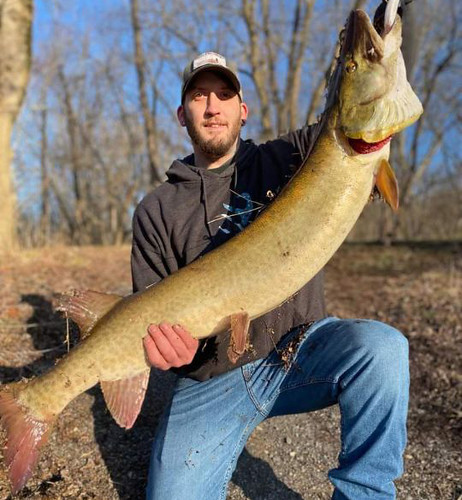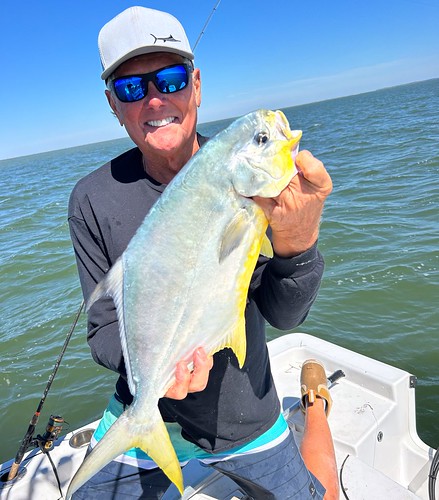
The Maryland state record common dolphinfish, also known as mahi, was caught Aug. 16, 2019 by Pasadena resident Kristy Frashure (seen here with husband Ryan) during a fishing tournament in Ocean City. She broke a record that had only held three weeks, but before that it had stood for 34 years. Photo by Steve Doctor, Maryland Department of Natural Resources.
Almost any angler would be thrilled to hold claim to a state record title, but few plan on it. A consistent theme among anglers who catch state records is their surprise when they land the fish, often thinking it was another species or even a snag because of the unexpected weight on their line.
While you can’t harness luck, there are steps Maryland anglers can take to increase their chances of hooking the largest fish of a given species in one of four divisions: Atlantic, Chesapeake, Nontidal, and Invasive.
For a record to stick, this fish must be caught legally. This means the angler must hold an active Maryland fishing license (unless exempt) and use legal fishing gear for the waterway they are fishing. Gear rules vary by waterway, season, and species. Brushing up on legal fishing methods is an important step all anglers should take. Rules can be reviewed on the Maryland e-regulations website or in the printed Maryland Guide to Fishing and Crabbing.
With the launch of the new MD Outdoors online licensing system, buying a license, checking its status, and renewing it—which now can be done automatically— is simpler than ever.

The state record muskellunge in the nontidal division, weighing 33.0 pounds, was caught by Kyle Mullenix in March 2022 along the banks of the upper Potomac River. Photo courtesy Kyle Mullenix.
The Department of Natural Resources (DNR) provides numerous tools and resources anglers can use in pursuit of a state record. The Angler Access Map lists hundreds of public fishing locations. Fish Facts pages provide detailed information on species, and the weekly Maryland Fishing Report offers up-to-date advice on what’s biting and where. DNR recently introduced an interactive Lakes and Ponds map, which provides access to DNR survey data such as population size distribution. And the department’s MD Outdoors App provides easy access to information from your mobile device.
Not every notable fish will set a state record. Anglers can still earn recognition for trophy-sized catches that don’t quite tip the scales for a record through DNR’s FishMaryland Program. Those who earn ten FishMaryland species awards for different species will achieve the coveted Master Angler milestone award.

Emma Zajdel — then 9 years old — set a still-standing Maryland state record on June 30, 2016 by reeling in a 94.6-pound cobia near Assateague Island. Maryland DNR photo.
If you do land a record-setting catch, then what? DNR recommends placing the fish in an ice bath until it can be weighed on a certified scale. Seafood markets, grocery stores, and some marinas or large tackle shops have scales that provide official weights. To complete the process, the angler must submit an official application (by email or mail), call 410-991-0748, and have the fish species confirmed by a DNR representative.
Many notable catches are inked in Maryland’s books. Some could stand for decades, while others are primed to be broken. One of the most breakable records is the 84-pound blue catfish record that has stood since 2012. This invasive species is abundant, widespread, and can grow to truly massive sizes.
Conversely, the most surprising recent record was the 17.44-pound rainbow trout landed by Jean-Philippe Lartigue in 2024. At the time of the catch, many DNR biologists thought the previous 14.2-pound record would never be broken.
So far in 2025, six new records have been set, including a 21.8-pound Chesapeake Channa (northern snakehead), and two false albacore records in the span of two weeks. By contrast, the longest-standing record is a 6.5-pound chain pickerel caught in 1965 in the Chesapeake Division.

Bobby Graves of Salisbury caught the state record Florida pompano in 2023. The warm water species was added to Maryland record books in 2019 after becoming more common in state waterways. Photo courtesy Bobby Graves.
In addition, Maryland waters have seen a marked increase of fish associated with warm water such as a few barracuda. Fishery managers expect to see more of this and other southern visitors, such as cobia, king mackerel, sheepshead, and pompano, and with them other new species added to the state record books.
The state record program highlights the quality of Maryland’s fisheries and the remarkable stories of the anglers who pursue them. All current records are listed on the DNR website.
Article by Sinclair Boggs, Marketing Strategist, Maryland DNR Fishing and Boating Services.
